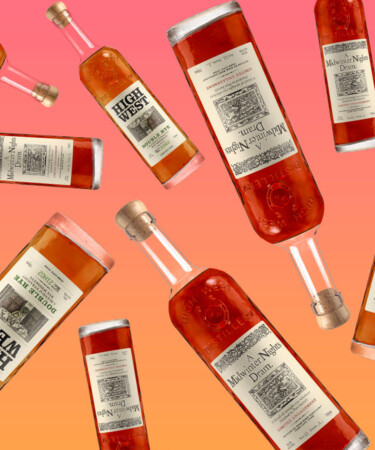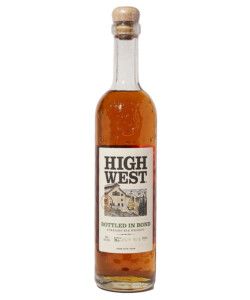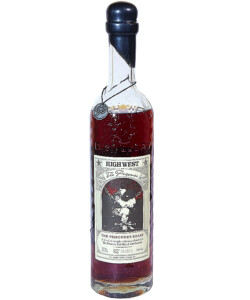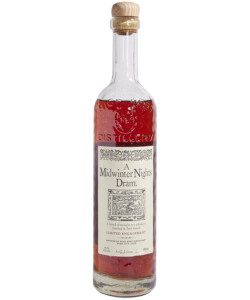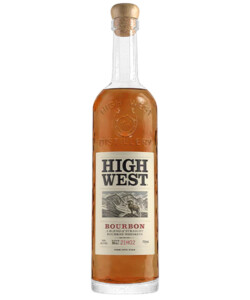Biochemist David Perkins and his wife Jane found themselves in Kentucky for a friend’s wedding in 2001. While in town, the couple stopped by Maker’s Mark for a distillery tour, during which David discovered the similarities between distilling and biochemistry — namely the key ingredient in any distilled spirit, ethanol. It then struck Perkins to open a whiskey distillery of his own.
The Perkins family relocated from California to Park City, Utah, and in 2006, High West Distillery was born. What started as a miniscule operation in a historic Park City stable has since grown to produce expressions including bourbon and rye as well as its beloved, limited-edition A Midwinter Night’s Dram. Known for its blended American whiskeys, High West is currently owned by Constellation Brands and occupies two spaces in Utah: the 25,000-square foot Blue Sky Ranch distillery in Wanship and the original distillery and saloon.
Now that you know the basics, here are nine things you should know about High West Distillery.
-
High West was the first distillery to open in Utah after Prohibition.
Though Utah had a rich distilling history prior to Prohibition — Salt Lake City’s Main Street was known as Whisky Street until 1870 — the abolition of alcohol production and consumption caused the state’s distilleries to shutter. Utah was left sans distillery until 2006, when High West became the first legal distilling operation in the state post-Prohibition. While Utah may have seemed like an odd choice for a distillery given its large and largely sober Mormon population, Perkins thought it would be ideal to open in a ski town like Park City. As he told Dartmouth’s Tuck School of Business, he envisioned people arriving at the distillery “to sit and have a glass of whiskey and reflect on their ski visit to the region,” similar to the common comfort of drinking a Corona on the beach.
-
The distillery is currently the world’s first ski-in ski-out gastro-distillery.
While the majority of High West’s distilling now takes place at its larger facility in Wanship, the brand’s original distillery in Park City (now known as the High West Saloon) is currently the world’s first ski-in, ski-out gastro-distillery. Nestled at the base of Park City Resort’s Quittin’ Time ski run, the Saloon offers each of High West’s expressions neat and in cocktails along with programmed whiskey tastings. The Saloon also has food covered for any guests who work up an appetite while skiing, serving a selection of alpine-inspired dishes that helped earn it an Outstanding Bar Program nomination from the James Beard Foundation in 2012.
-
The High West Saloon operates out of a century-old building in Park City.
Constructed in 1907, the High West Saloon building was originally built as a horse stable for a mining company that used the animals to transport carts up and down the mine shafts. Over the decades, the building changed hands many times and served numerous roles, serving as a horse stable, a wagon supply store, and numerous auto body shops.
With each of these changes, the building’s main sign was repainted. But in 1981, the building’s facade was badly damaged when a fire broke out at the Silver King Coalition Mines Company building across the street. The extreme temperatures melted away several layers of paint, resulting in the multi-layered effect still seen on the structure today. In 2008, when High West restored the building, its sign was revitalized and preserved to showcase the site’s historic significance.
-
The horseshoe on the logo pays homage to a piece of Park City’s history.
While renovating the structure that would become the High West Saloon, a contractor uncovered a horseshoe remaining from the building’s livery days. Discovering a piece of Salt Lake City’s mining history right on its own property inspired David to incorporate a horseshoe into the brand’s logo design, which features an outline of the Rocky Mountains between the horseshoe’s branches. According to the brand, the logo serves as a symbolic reminder that good things, like good whiskey, will stand the test of time. Today, the original horseshoe remains on display at the Saloon.
-
High West demonstrates why distillers shouldn’t shy away from sourcing spirits.
Given the lengthy maturation period whiskey must undergo before it can be released, it can often take many years for a distillery to become profitable. As such, many brands choose to source finished whiskey from other producers and bottle it under their own brands or blend it with their own in-house spirits, the latter a celebrated practice at High West Distillery. Perkins credits Jim Rutledge, Four Roses’ former master distiller, with giving him the idea for this kind of sourcing as the two consulted while building out the distiller’s business plan. While many brands shy away from admitting where they get their liquid in their bottles, High West is transparent about its production philosophy, disclosing where it sourced its spirits when contractually possible as well as how much of the spirit ends up in the final blend. The brand also seeks to educate consumers on how long it takes to produce a bottle of high-quality whiskey, and why sourcing whiskeys for blending should be a practice that’s championed rather than sneered at.
-
There’s some Scottish influence in the brand’s whiskey making.
With the exception of High Country American Single Malt and Bottled In Bond, all the distillery’s existing whiskeys have been blended in part with externally sourced spirits. High West master distiller Brendan Coyle, who obtained a master’s degree in brewing and distilling science from Heriot-Watt University in Edinburgh, fell in love with the tradition of blending in Scotch whisky production while completing his studies. According to the brand, he’s now intent on opening up more consumers’ minds to the flavor profiles that can be unlocked when blending. For example, the brand’s Double Rye!, which incorporates whiskey sourced from Indiana’s MGP, emits dried herb, maple wood, and black pepper aromas while Rendezvous, also made with with MGP-sourced rye, leans sweeter with notes of yellow plum jam, cocoa-dusted orange peels, and boysenberry turnover. The brand also doesn’t shy away from blending multiple types of whiskey: Bourye is a dessert-like blend of bourbon and rye, while Campfire combines Scotch, bourbon, and rye to achieve flavors like chai spice, vanilla, orange zest, and spicy gingerbread.
-
The brand uses barrels to give its existing spirits new life.
While the majority of High West’s exploration with flavor profiles comes down to the final blend, the brand switches up the barrels it uses, as demonstrated by A Midwinter Night’s Dram, the distillery’s coveted annual release named for David and Jane’s shared love for Shakespeare. The liquid itself is the brand’s Rendezvous Rye, though this expression sees the whiskey split and aged in both tawny port and ruby port barrels before they’re blended and bottled at 49.3 percent ABV. Act 11, 2023’s release, washes the palate in berry, ginger, and baking spice notes.
-
High West is committed to running an ecologically friendly distilling operation…
The company has prioritized decreasing its carbon footprint wherever possible, offsetting 100 percent of the electricity used across both of its facilities through credits provided by Rocky Mountain Power’s Blue Sky power program. Additionally, all the grain used to distill High West whiskey is sourced from local producers within a day’s drive of the distillery to decrease time spent in transit. After each round of distillation, the spent grain is then offloaded and sent to an anaerobic digester, which produces methane gas used to power the Salt Lake City electrical grid.
-
…and preserving the Rocky Mountain landscape it calls home.
Since its founding, High West has witnessed decreasing snowfall during Utah’s winters and an alarming increase of wildfires in the summer, which have caused destruction in the landscape. As such, the distillery has pledged to donate $1 million over the course of the next three years to organizations working to protect the state’s natural habitats, such as the Wildland Firefighter Foundation, Protect Our Winters (POW), and American Prairie.
